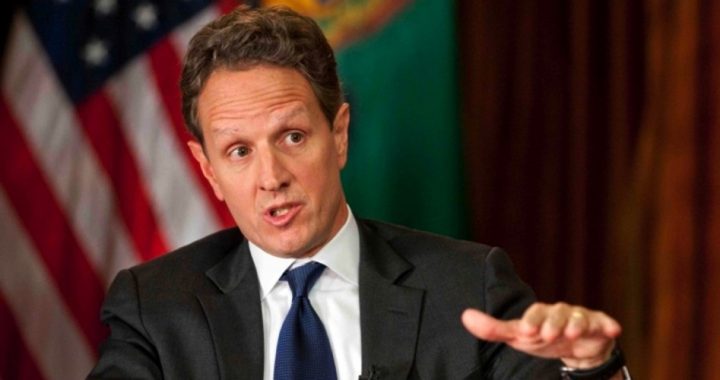
Former Treasury Secretary Timothy Geithner (shown) announced his plans to join the Wall Street private equity firm Warburg Pincus in March 2014 where he will serve as president and managing director.
Geithner is the proto-typical insider with establishment ties that follows almost exactly the script laid out by James Perloff in his treatise, The Shadows of Power: The Council on Foreign Relations and The American Decline. Wrote Perloff:
In the public mind, the American Establishment is probably most associated with big business and with wealthy, old-line families. The sons of these families have long followed a traditional career path that begins with private schools….
From there they have typically proceeded to Harvard, Yale, Princeton or Columbia….
From academia they have customarily progressed to Wall Street….
As they have matured, a few have found themselves on the boards of vast foundations: Rockefeller, Ford and Carnegie….
Ultimately some have advanced into “public service”: high positions in the federal government. For [them] there has long been a requisite: membership in … the Council on Foreign Relations … the Establishment’s chief link to the U.S. government.
Geithner’s time line uncannily follows Perloff’s script. He is the son of Peter Franz Geithner, who was a director at the Ford Foundation. His mother’s father, Charles Frederick Moore, Jr., served as a vice president at the Ford Motor Company. After completing high school at the International School Bangkok, a private school for the children of United States diplomats, Geithner went on to attend Dartmouth College, getting his BA in government in 1983. From there he attended Johns Hopkins University, graduating in 1985 with an advanced degree in international studies.
Without skipping a beat, Geithner went to work for the secretive Kissinger Associates as a research assistant for three years, moving on from there to the U.S. Treasury’s International Affairs division. From there he became Undersecretary of the Treasury under two successive treasury secretaries, Robert Rubin (former chairman of Wall Street’s infamous Goldman Sachs and now serving as co-chairman at the Council on Foreign Relations) and Lawrence Summers.
In 2001 he left the Treasury to become a senior fellow in the International Economics department at the Council on Foreign Relations, and two years later became a director at the International Monetary Fund (IMF). In 2003 he became president of Federal Reserve Bank of New York where he served as Vice Chairman of the Fed’s Open Market Committee.
In 2006 he joined the Group of Thirty consisting of the heads of major private and central banks, founded in 1978 at the insistence of the Rockefeller Foundation, which funded the group. The Group of Thirty’s first chairman was the managing director of the IMF.
His legacy at the Treasury and the New York Federal Reserve included arranging bailouts for companies such as Citigroup, General Motors, and American International Group (AIG). He supervised the Troubled Assets Relief Program (TARP) and became President Obama’s point man in promoting the Dodd-Frank financial overhaul law. He arranged the sale of Bear Stearns to Bank of America and bailed out AIG (a prime lender to Goldman Sachs) while letting Lehman Brothers fail and descend into bankruptcy.
He has been criticized for his handling of those bailouts, especially those that kept AIG afloat with infusions of some $170 billion of taxpayers’ money while AIG simultaneously paid out massive bonuses to its top executives. Geithner found himself in trouble when it was learned that he had advised AIG not to include mention of those bonuses either publicly or in its SEC filings.
His new firm, Warburg Pincus, has ties to the establishment as well. The private equity firm, with some $35 billion in assets, buys up faltering companies and then sells them after they have recovered, taking management fees along the way and 20 percent of profits upon final sale. Eric Warburg of the Warburg banking family founded the company in 1939, and located its offices (appropriately) in the Kuhn Loeb building on William Street in New York City. In 1966 it was merged with Lionel I. Pincus & Co. to become Warburg Pincus.
Recent sales have included the buyouts of Bausch & Lomb, Neiman Marcus, and stadium concessionaire Aramark. Geithner hopes to manage and grow the firm, using his extensive A-list Rolodex of contacts gained from years of working at the very top of the American and international establishments. Said Geithner: “When they approached me, they clearly wanted me to play a substantive role in helping them manage the firm … [it is] culturally very compatible with what I was looking for.”
Howard Marks, another insider whose connections allowed his company, Oaktree Capital Group, to earn outsized returns during the Great Recession, said this about fellow insider Geithner:
Hopefully he can provide leadership for the firm, spiritual leadership if you will. What Geithner did for his country — to have committed this much of his life to government service — is a wonderful thing.
You can’t penalize him further by saying “and now you can’t go out and get a profitable job.”
While details on his compensation in his new position weren’t available, it’s clear that, according to the path Geithner has been following since birth, he will now, at age 52, begin to reap the material rewards for his “government service.”
Photo of former Treasury Secretary Timothy Geithner: AP Images
A graduate of Cornell University and a former investment advisor, Bob is a regular contributor to The New American magazine and blogs frequently at www.LightFromTheRight.com, primarily on economics and politics. He can be reached at [email protected].



